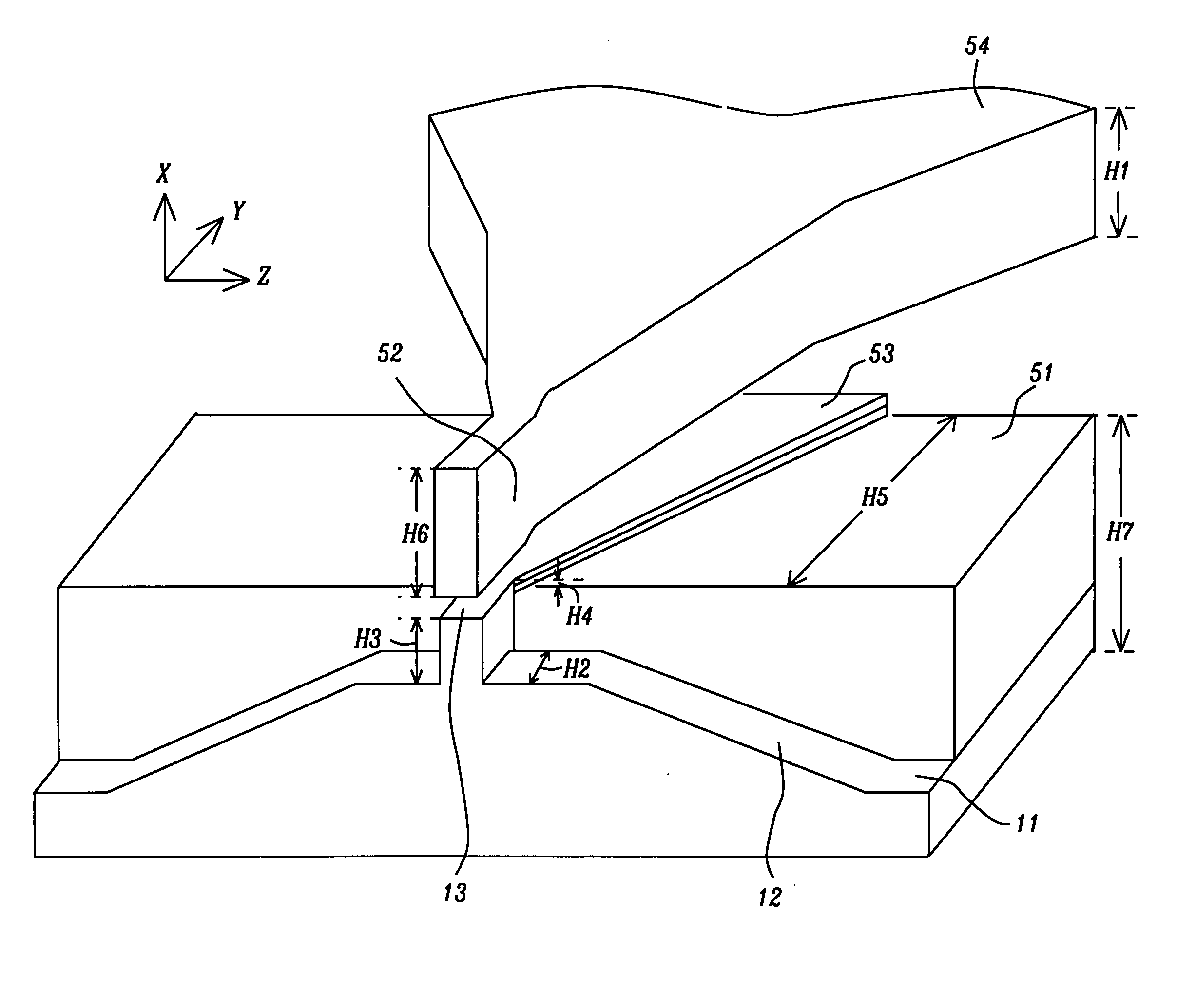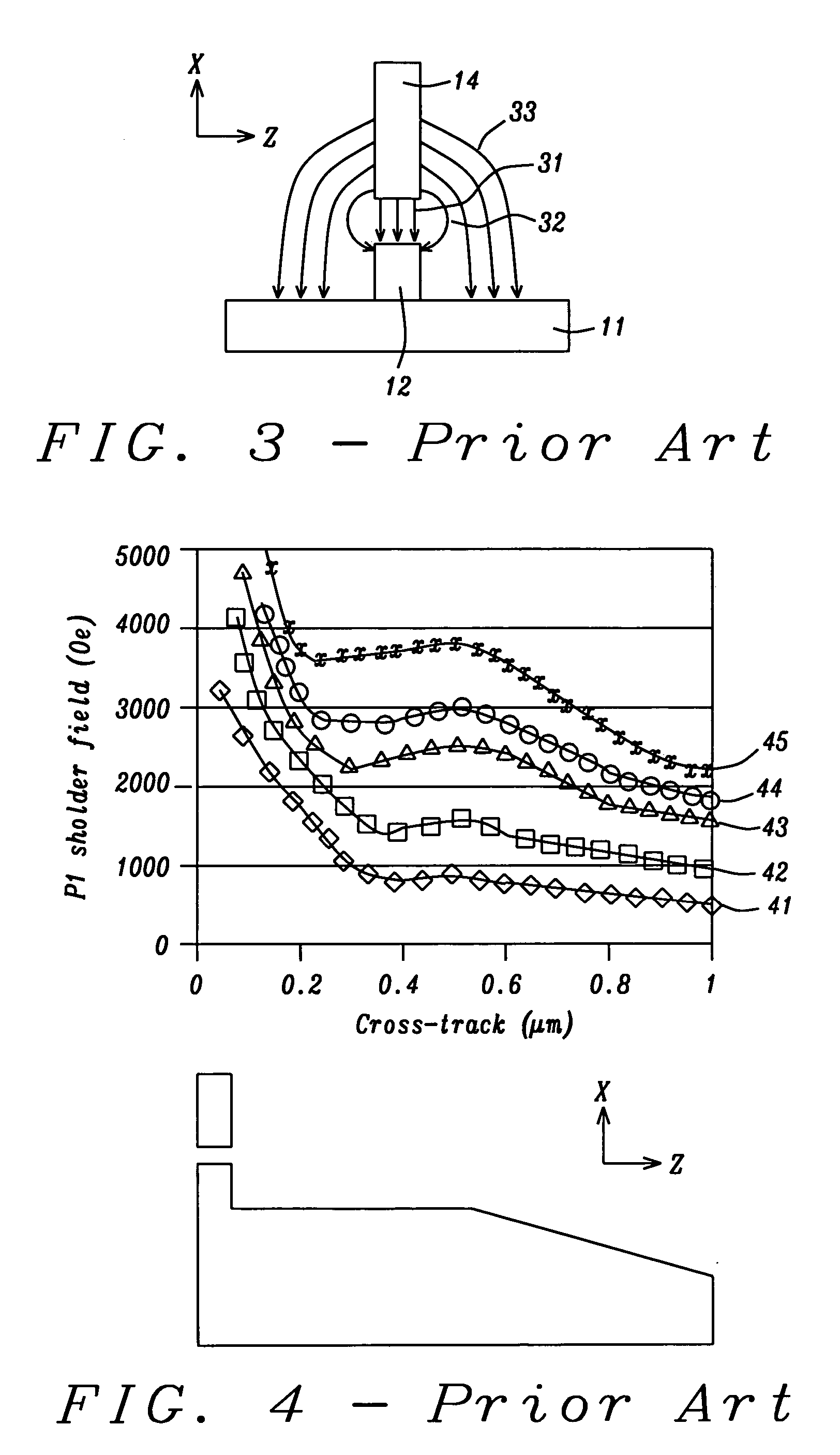Bottom pole structure with back-side steps
a bottom pole structure and back-side step technology, applied in the field of magnetic write heads, can solve the problems of frequent erasure of adjacent tracks, severe excess saturation of the head,
- Summary
- Abstract
- Description
- Claims
- Application Information
AI Technical Summary
Benefits of technology
Problems solved by technology
Method used
Image
Examples
first embodiment
[0023] Returning now to FIG. 5, we continue our description of the invention. The bottom pole has been divided into front and rear sections with a step between them. The front section comprises the sub-structures 11 and 12 along with flux concentrator 13. The rear section (to which the front section is attached) is rectangular prism 51 whose top surface is higher than the top flat portion of element 12 (from which concentrator 13 upwardly extends). The top surface of concentrator 13 is higher than that of prism 51 and, furthermore, flux extender 53 runs from the inside edge of 51 all the way to the back edge of 51. So, as one moves through the write gap, away from the ABS, there is a decrease in the reluctance between the top and bottom poles, except in the write gap region itself. As a result, excess flux generated by higher write currents can be absorbed by the flux extender instead of being diverted to the side of the write gap.
[0024] The key dimensions that determine the perform...
2nd embodiment
2nd Embodiment
[0031] This is illustrated in FIG. 9. This structure is similar to the first embodiment except that there is no end piece (element 52 in FIG. 5). The key dimensions that determine the performance of the device seen in FIG. 9 are as follows:
[0032] Top pole thickness (H1)—between about 0.7 and 2 microns; thickness separating the trapezoidal walls of element 12 (H2)—between about 0.3 and 1 microns; flux concentrator thickness (H3)—between about 0.1 and 0.4 microns; flux extender thickness (H4)—less than about 0.3 microns; distance flux extender extends from the flux concentrator (H5)—between about 0.5 and 2 microns; and height of rectangular prism (H7)—between about 2 and 4.5 microns.
3rd embodiment
3rd Embodiment
[0033] This is illustrated in FIG. 10. This structure is similar to the second embodiment except that rectangular prism 99 does not extend all the way to the outer edge of flat layer 11. The key dimensions that determine the performance of the device seen in FIG. 9 are as follows:
[0034] Top pole thickness (H1)—between about 0.7 and 2 microns; thickness separating the trapezoidal walls of element 12 (H2)—between about 0.3 and 1 microns; flux concentrator thickness (H3)—between about 0.1 and 0.4 microns; flux extender thickness (H4)—less than about 0.3 microns; distance flux extender extends from the flux concentrator (H5)—between about 0.5 and 1.5 microns; and height of rectangular prism (H7)—between about 2 and 4.5 microns.
PUM
| Property | Measurement | Unit |
|---|---|---|
| thickness | aaaaa | aaaaa |
| thickness | aaaaa | aaaaa |
| thickness | aaaaa | aaaaa |
Abstract
Description
Claims
Application Information
 Login to View More
Login to View More - R&D
- Intellectual Property
- Life Sciences
- Materials
- Tech Scout
- Unparalleled Data Quality
- Higher Quality Content
- 60% Fewer Hallucinations
Browse by: Latest US Patents, China's latest patents, Technical Efficacy Thesaurus, Application Domain, Technology Topic, Popular Technical Reports.
© 2025 PatSnap. All rights reserved.Legal|Privacy policy|Modern Slavery Act Transparency Statement|Sitemap|About US| Contact US: help@patsnap.com



